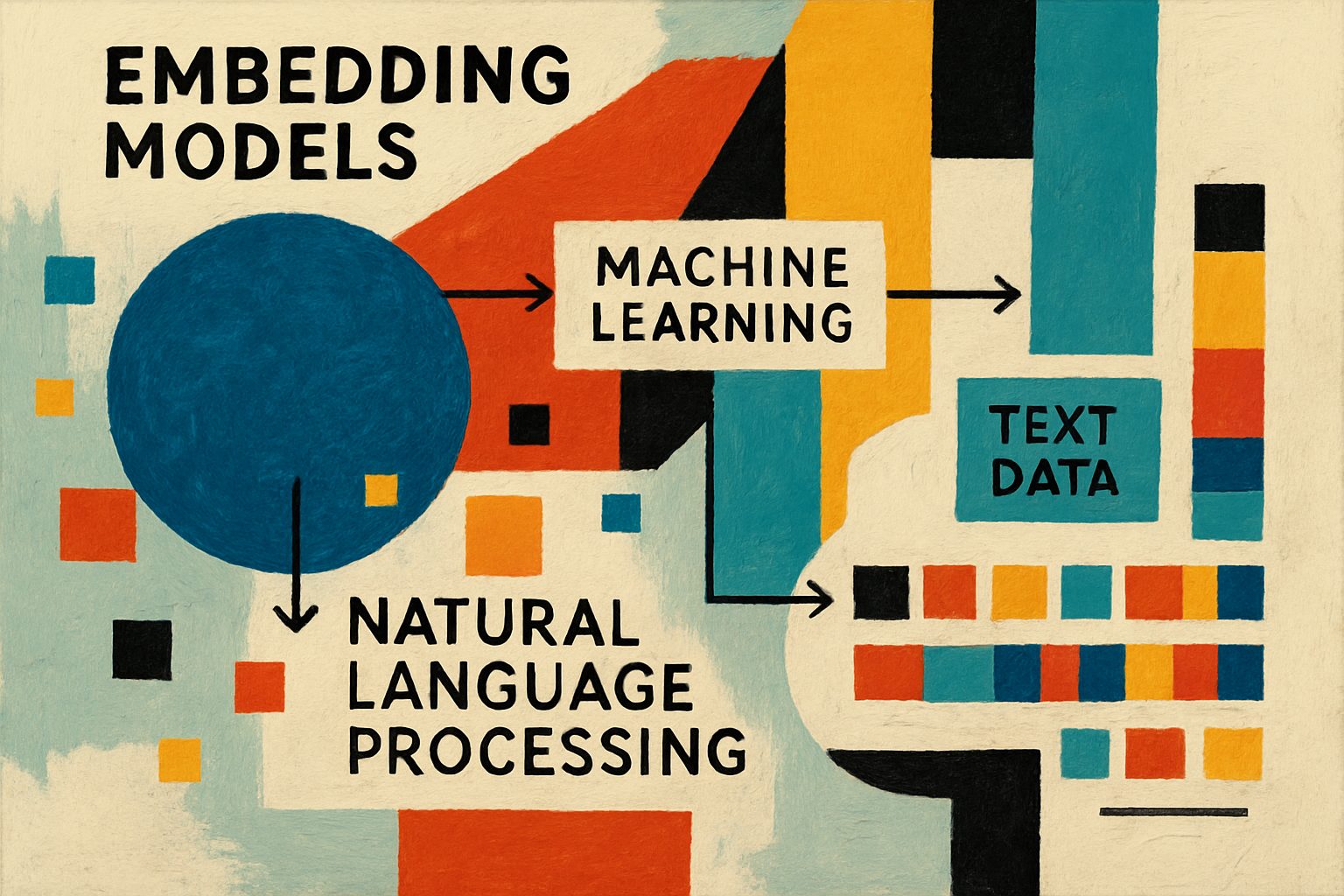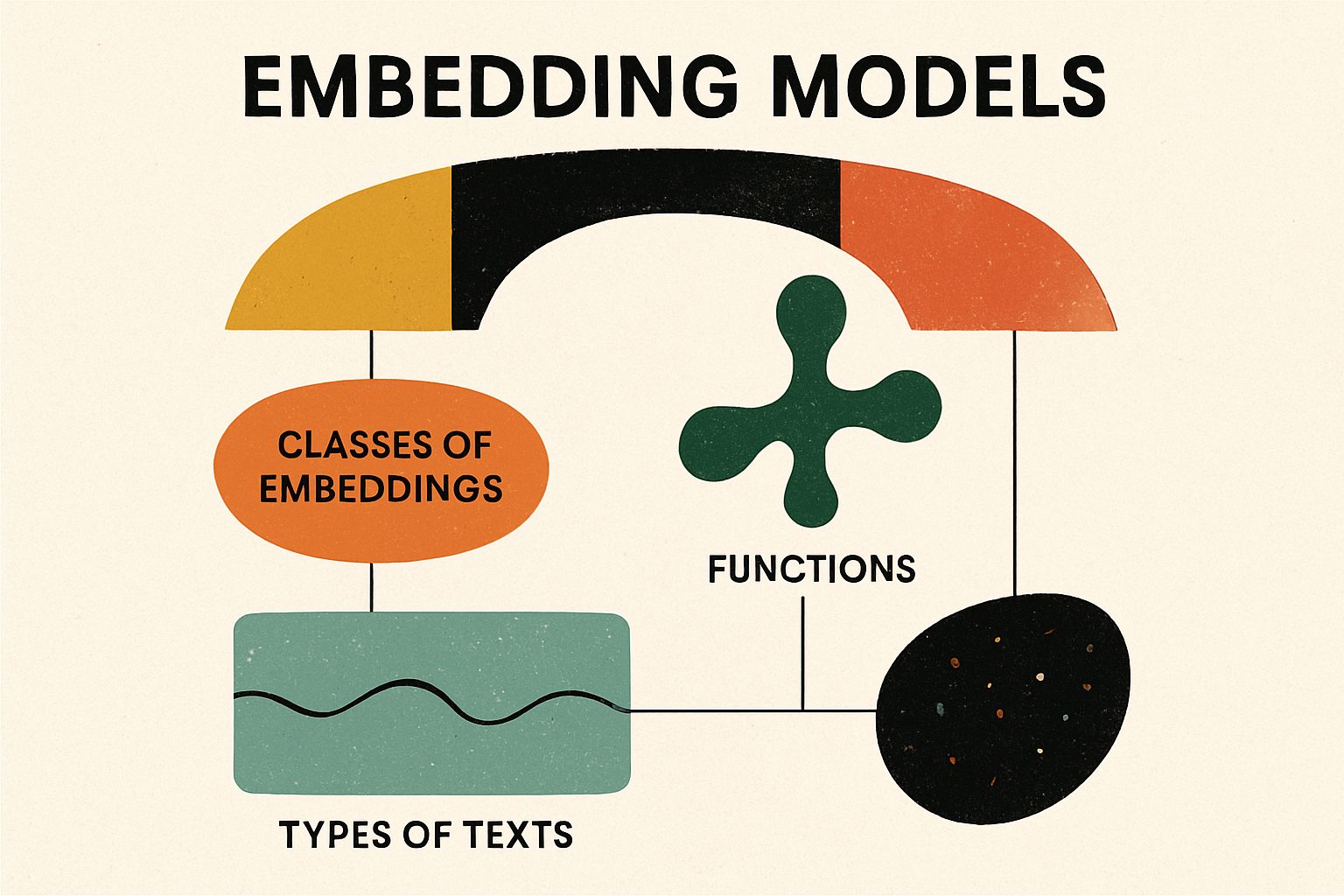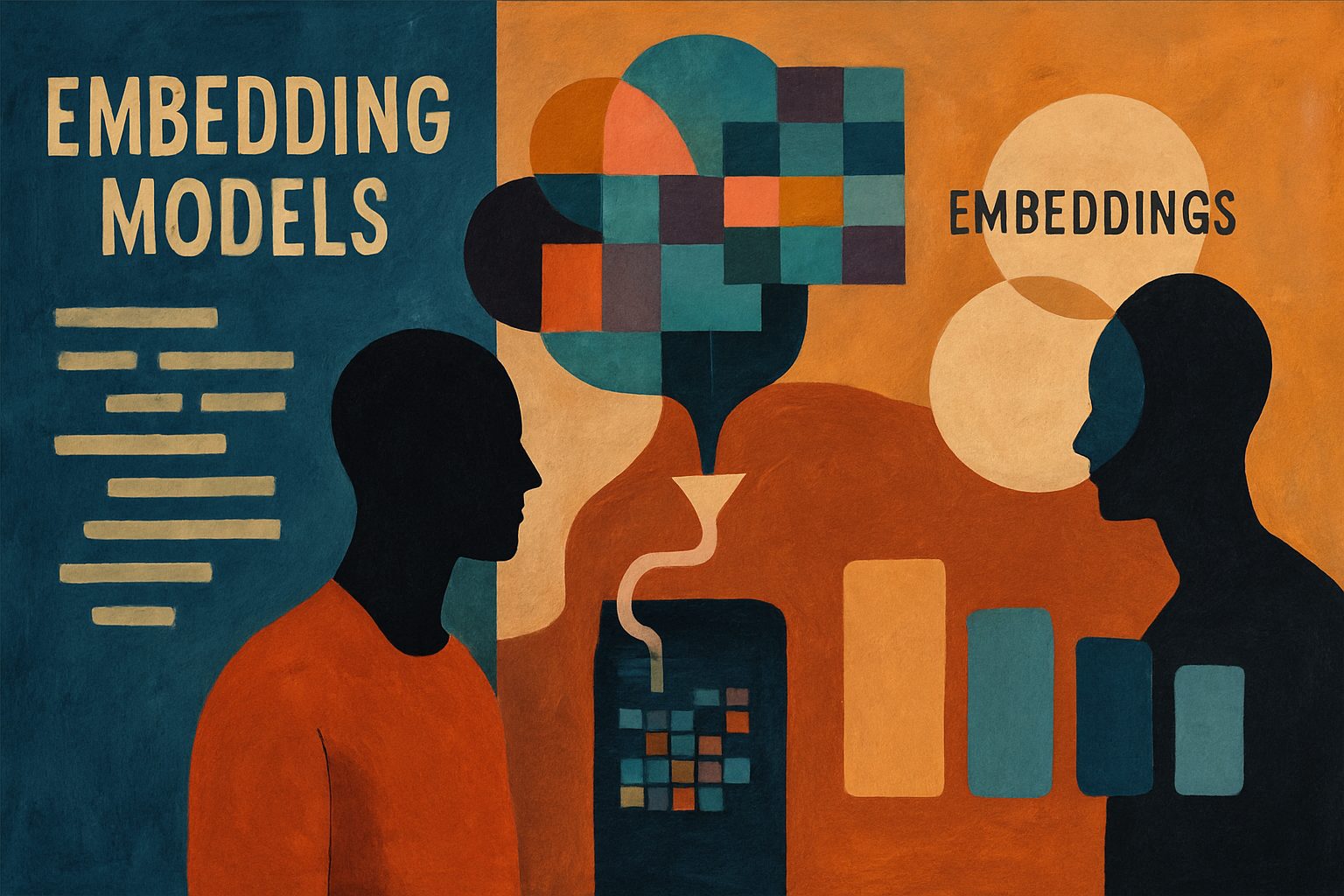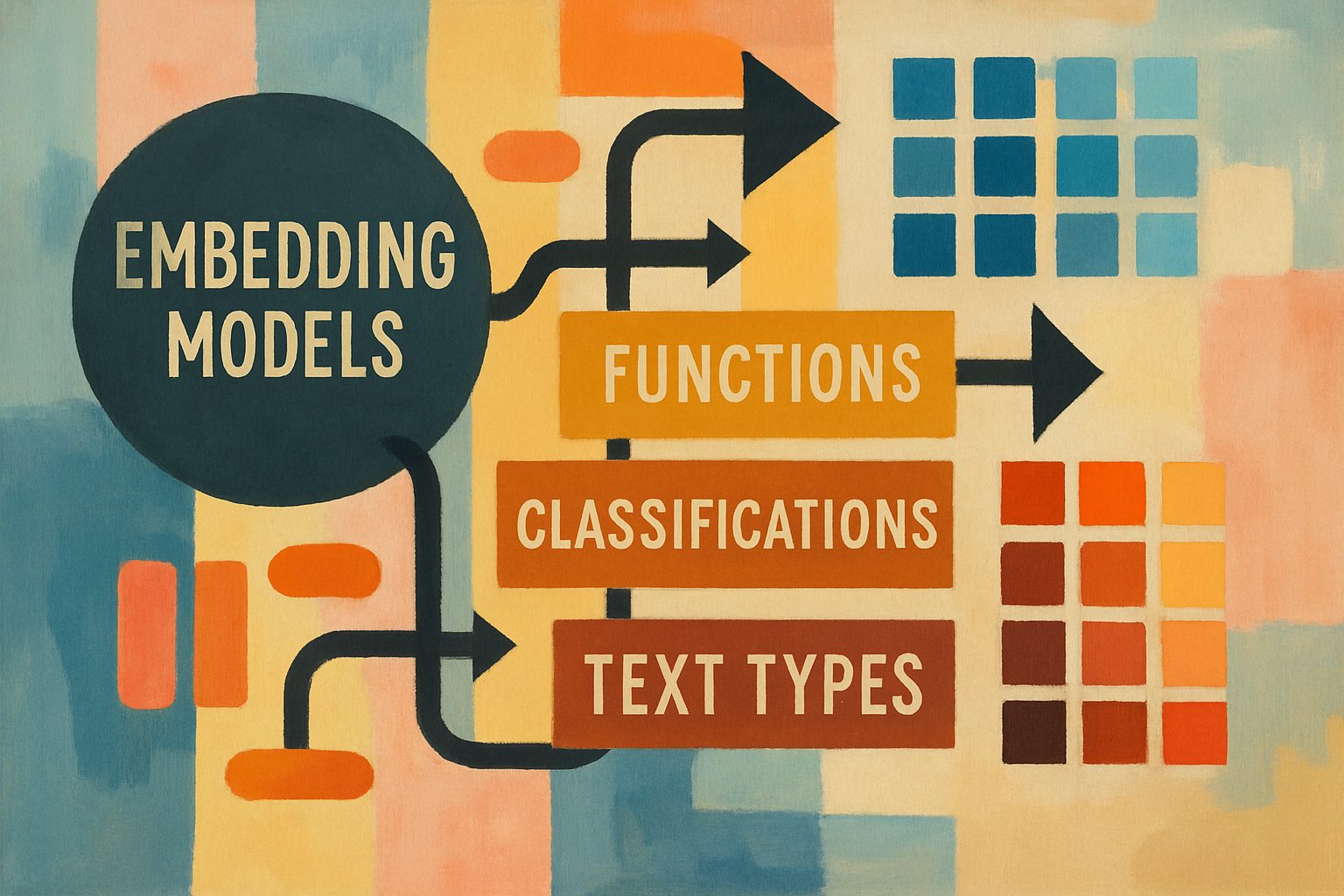
Unlocking the Power of Embeddings: A Deep Dive into Models and Their Applications
Discover the fascinating world of embedding models in machine learning and natural language processing. This article unravels the types of embeddings available, their specific applications, and how they transform text data into actionable insights.
This comprehensive analysis explores Compare the various embedding models and explain their functions, as well as the different classes of embeddings available. Specifically, identify which embeddings are suitable for different types of texts, illustrate this relationship, and elucidate the reasons behind it., based on extensive research and multiple data sources.

Thesis Statement
Embedding models play a crucial role in the field of machine learning and natural language processing by transforming data into numerical representations that can be easily processed by algorithms. This document aims to provide a comprehensive list of popular embedding models, highlighting their applications, strengths, and limitations.
Overview of Embedding Models
Embedding models are designed to convert complex data types into dense vector representations. They enable machine learning algorithms to understand and manipulate high-dimensional data more effectively. Below is a curated list of some of the most notable embedding models available today.
1. Word2Vec
- Description: Developed by Google, Word2Vec is a shallow neural network model that learns word associations from large datasets. It can generate word embeddings based on the context of surrounding words.
- Variants: Continuous Bag of Words (CBOW) and Skip-gram.
- Use Cases: Semantic similarity, text classification, and recommendation systems.
- Source: Word2Vec
2. GloVe (Global Vectors for Word Representation)
- Description: Developed by Stanford, GloVe is an unsupervised learning algorithm that creates word embeddings by aggregating global word-word co-occurrence statistics from a corpus.
- Applications: Similar to Word2Vec, often used in NLP tasks.
- Source: GloVe
3. BERT (Bidirectional Encoder Representations from Transformers)
- Description: BERT is a transformer-based model that understands the context of words in a sentence through bidirectionality. It generates embeddings that capture the meanings of words based on their context in phrases.
- Use Cases: Question answering, sentiment analysis, and named entity recognition.
- Source: BERT
4. OpenAI’s Ada-002
- Description: A state-of-the-art embedding model from OpenAI, Ada-002 can process extensive textual data into embeddings while maintaining semantic relationships.
- Output Dimensions: 1536.
- Use Cases: Text similarity, clustering, and classification.
- Source: OpenAI Ada-002
5. Titan Embeddings
- Description: Part of AWS’s offerings, Titan Embeddings provides a robust solution for generating embeddings up to 8K tokens with a vector length of 1536.
- Applications: Semantic similarity, text retrieval, and clustering.
- Source: Amazon Web Services
6. ModernBERT
- Description: An adaptation of the BERT model, ModernBERT aims to enhance both speed and accuracy in generating embeddings, making it suitable for larger datasets.
- Output Dimensions: Available in multiple configurations (Base: 768, Large: 1024).
- Source: ModernBERT
7. Voyage Embeddings
- Description: The Voyage family of models (e.g., voyage-3-large, voyage-3-lite) are noted for their impressive performance in information retrieval tasks, with a focus on cost-effectiveness.
- Output Dimensions: Ranges from 512 to 2048.
- Source: Voyage Models
8. Jina Embeddings
- Description: A flexible embedding solution that is particularly useful for building search applications, offering a variety of embeddings.
- Output Dimensions: 1024.
- Source: Jina
9. Cohere Embed
- Description: A model that emphasizes ease of use and integration into various applications, particularly in NLP.
- Output Dimensions: 1024.
- Source: Cohere
10. Stella
– Description: An open-source model that has gained recognition for its performance in various tasks. It comes in different sizes (e.g., 400M and 1.5B parameters).
Embedding models are crucial in transforming complex data structures into lower-dimensional representations, making them easier for machine learning models to process. This document will provide a detailed overview of various embedding models, their functions, and operational mechanics, while weighing evidence from multiple perspectives to develop a comprehensive understanding.
Thesis
Embedding models facilitate the representation of high-dimensional data in a lower-dimensional space, preserving semantic relationships and enabling various machine learning tasks. Understanding these models is essential for leveraging their potential in applications such as natural language processing (NLP), computer vision, and recommendation systems.
Types of Embeddings
1. Word Embeddings
Word embeddings are dense representations of individual words in a continuous vector space. Notable examples include Word2Vec, GloVe, and FastText.
-
Word2Vec: Developed by Google, Word2Vec employs two architectures—Continuous Bag of Words (CBOW) and Skip-Gram—to capture the context of words in large datasets. CBOW predicts a target word based on its context, while Skip-Gram does the reverse, predicting surrounding words based on a given word. For instance, in a vector space, “king” and “queen” would be represented as vectors close to each other, reflecting their semantic relationship (source).
-
GloVe (Global Vectors for Word Representation): GloVe focuses on capturing global statistical information by factorizing the word co-occurrence matrix. It generates embeddings based on the frequency of word pairs appearing together in a large corpus, preserving the overall context (source).
-
FastText: An extension of Word2Vec, FastText represents words as bags of character n-grams. This allows it to capture sub-word information, making it particularly effective for morphologically rich languages and out-of-vocabulary words (source).
2. Sentence Embeddings
Sentence embeddings aim to capture the meaning of entire sentences or paragraphs, rather than just individual words. Examples include:
-
Universal Sentence Encoder: This model uses deep averaging networks to create sentence embeddings by averaging word embeddings and applying a feedforward neural network to produce a fixed-size output vector (source).
-
Sentence-BERT (SBERT): By fine-tuning BERT (Bidirectional Encoder Representations from Transformers), SBERT generates embeddings that can be used for semantic similarity tasks, yielding superior performance in tasks like clustering and information retrieval (source).
3. Image Embeddings
Image embeddings are generated from images using models like Convolutional Neural Networks (CNNs). These embeddings translate visual data into a format that machine learning systems can understand.
- CNN-based Models: CNNs extract features from images, producing embeddings that can be used for classification or retrieval tasks. For instance, an image of a cat may be represented by a vector closely related to vectors of other cat images, facilitating tasks such as image classification and recognition (source).
4. Graph Embeddings
Graph embeddings involve mapping nodes or subgraphs into vector spaces, preserving the structural relationships of the graph.
- DeepWalk and GraphSAGE: These models leverage random walks and neighborhood aggregation techniques to create embeddings that capture the graph’s connectivity. Graph embeddings are particularly useful in social network analysis and recommendation systems (source).
Operational Mechanics of Key Models
| Model | Type | Key Features | Use Cases |
|---|---|---|---|
| Word2Vec | Word Embedding | CBOW and Skip-Gram architectures | NLP tasks, semantic similarity |
| GloVe | Word Embedding | Global co-occurrence matrix |
In the rapidly evolving field of natural language processing (NLP) and machine learning, embeddings serve as a cornerstone technology. They transform text data into numerical representations, enabling machines to comprehend and process language effectively. This analysis aims to categorize various embedding types based on their suitability for different text types, ultimately identifying the embeddings that work best for specific text categories.
Thesis
The categorization of embeddings based on text types is essential for optimizing their application in various NLP tasks, as different embeddings capture semantic meanings at different granularities and complexities.
Types of Text and Corresponding Embeddings
Embeddings can be categorized based on the level of granularity (words, sentences, paragraphs) and the nature of the text they are best suited for (e.g., conversational, formal, technical). Below is a structured overview of various types of embeddings and their suitable text types:
| Embedding Type | Description | Best Suited Text Types |
|---|---|---|
| Word Embeddings | Represent individual words as vectors, capturing semantic relationships. | Informal text, conversational data, social media |
| Sentence Embeddings | Capture the meaning of entire sentences or phrases as single vectors. | News articles, reviews, social media posts |
| Document Embeddings | Represent entire documents, aggregating sentence embeddings. | Research papers, reports, long articles |
| Character Embeddings | Represent individual characters, useful for handling rare words or typos. | Technical documents, code, languages with rich morphology |
| Contextual Embeddings | Generate dynamic embeddings based on word context (e.g., BERT). | All text types, particularly complex sentences |
| Multimodal Embeddings | Combine text with other modalities (e.g., images, audio). | Social media, e-commerce (product descriptions with images) |
Detailed Analysis of Each Embedding Type
- Word Embeddings
- Examples: Word2Vec, GloVe, FastText
- Use Cases: Effective for tasks like sentiment analysis and word similarity tasks. They excel in capturing semantic relationships between words. For instance, the analogy “king – man + woman ≈ queen” demonstrates how these embeddings encapsulate gender relationships in language.
-
Best for: Informal text, social media posts, and conversational data, where the focus is on individual words and their meanings.
-
Sentence Embeddings
- Examples: Universal Sentence Encoder, Sentence-BERT
- Use Cases: Ideal for tasks requiring understanding of entire sentences, such as semantic textual similarity and sentence classification.
-
Best for: News articles, reviews, and any text requiring an understanding of context and meaning at the sentence level.
-
Document Embeddings
- Examples: Doc2Vec
- Use Cases: Useful for clustering and classifying entire documents. They aggregate the meanings of sentences into one vector, making them suitable for document retrieval and recommendation systems.
-
Best for: Research papers, legal documents, and extensive reports, where the overall context is crucial.
-
Character Embeddings
- Examples: Character-level models in RNNs
- Use Cases: Particularly useful in cases where the vocabulary is large or constantly evolving, such as in technical writing or when dealing with languages that have complex morphology.
-
Best for: Technical documents, coding languages, and texts containing many rare words or typos.
-
Contextual Embeddings
- Examples: BERT, ELMo
- Use Cases: Capture the meaning of words based on their context in a sentence. Such embeddings are crucial for understanding polysemy (words with multiple meanings).
-
Best for: All text types, especially those where context dramatically shifts meaning, such as literary texts or nuanced social discourse.
-
Multimodal Embeddings
- Examples: CLIP (Contrastive Language-Image Pretraining)
- Use Cases: They can link text descriptions with images or other media, enhancing tasks such as image captioning or multimedia search.
- Best for: Social media content, e-commerce product descriptions, and any domain where text and image data overlap.
Critical Analysis of Embedding Selection
When choosing the right embedding, several factors must be weighed:
- Type of Text: The complexity and nature of the text dictate the choice of embedding. For example, informal texts benefit from word embeddings, while formal, technical documents may require character or document embeddings.
- Task Requirements: Embeddings should align with the specific NLP task. For instance, sentiment analysis may thrive on word
Vyftec – Embedding Models Analysis
Unlock the power of AI with our expert analysis on embedding models tailored for various text types. Experience Swiss quality solutions that elevate your project—let’s connect!
📧 damian@vyftec.com | 💬 WhatsApp


